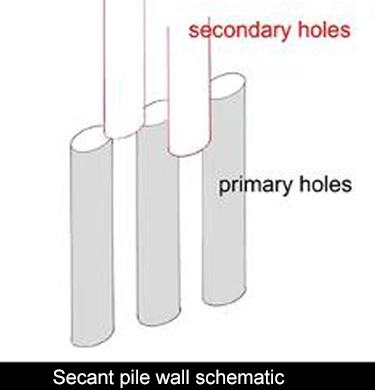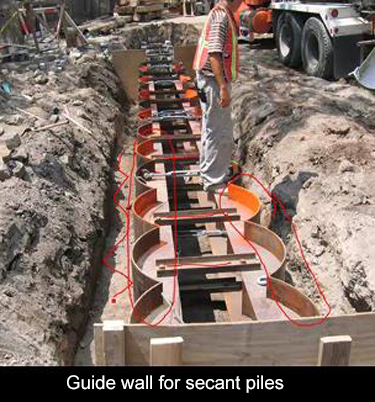Welcome to support of excavation part 2. In part 2, we look at two advanced techniques for supporting excavations. The first are secant pile walls. Illustrated here is a very deep and wide excavation in lower Manhattan, for the construction of a new subway terminal.
The second method are slurry walls. We go back with a little history of the use of slurry walls at the World Trade Center and then we move into current applications. We include details of how slurry walls are built and why the slurry wall process works.
The first method in this class is secant pile walls. They are an excellent tool rather quickly built. The systems are very strong and watertight and extremely robust.
 You begin by installing a drilled shaft, which is nothing more than a hole in the ground filled with concrete. You skip a space, and then you drill the next drilled shaft and fill it with concrete. and then you continue with the third. You can do this for the full length of the wall, or for some practical distance.
You begin by installing a drilled shaft, which is nothing more than a hole in the ground filled with concrete. You skip a space, and then you drill the next drilled shaft and fill it with concrete. and then you continue with the third. You can do this for the full length of the wall, or for some practical distance.
When the concrete is set, you return to drill the intermediate holes. The first polls are called the primary holes, and the intermediate holes are called the secondary holes. It's a real challenge to keep that secondary hole in place and aligned with the primary holes.
If you've had any experience drilling holes, even as a homeowner, you know that that drill will want to skip away from those two hardened shafts and find the soft material and drill through the soft material. How do you lock that secondary hole in place? How do you fix that location and keep it in that location for the full length of the drilling?
You begin by starting with a very heavy, low center of gravity drill rig. Because of the massive weight of this rig, this upper connection can be considered as a fixed point. The drill will be held in place and will not move. Now the challenge is at the point of entry at the point of the drill. This is the point where the drill will want to escape and drill into the soft material.
 How do you lock this in place and hold this in place for the full length of the drilling? You do this by constructing a starter wall, which is also called a guide wall, because it guides the location of that drill. Here you can see a series of metal forms. There's one on each side, and you can see how they are configured to create that precise overlapping pattern of the drilled holes.
How do you lock this in place and hold this in place for the full length of the drilling? You do this by constructing a starter wall, which is also called a guide wall, because it guides the location of that drill. Here you can see a series of metal forms. There's one on each side, and you can see how they are configured to create that precise overlapping pattern of the drilled holes.
Now, of course, here you looking at the form. You need to fill the space behind the form with concrete. When the concrete is set, you dismantle the forms and remove them. Now you've created a concrete wall with that perfect scalloped shape.That guides the location of the drill bit and keeps it in place for the full length of the drilling.
There is a practical limitation and I believe 90 feet is considered a reasonable limit for the length of these drilled shafts. It's impossible to ensure that each shaft is 100% plumb. To allow for some small amount of out of plumbness, you should limit the height to 90 feet. Within that height, the shafts will always be an intimate contact.
People are still making wood forms. You don't really need to go to the factory and have a prefabricated metal form. When I began in this business, all of the formwork was built on site out of wood. We created the most complex, interesting shapes. Of course, they produced the most interesting, concrete end product.
It was a real challenge for me to design wood forms, to make them strong enough to carry the load of the concrete. Very often they had these complex shapes. This was a wonderful engineering assignment and it also brought me in contact with the craftsmen that would build the forms and use the forms.
Over the years, the industry is moved more and more to prefabricated metal forms. The unfortunate result is that the designs have been dumbed down to use these very plain and simple forms. That's really unfortunate, but the skills are still there and engineers should not hesitate to make more demanding, more challenging shapes. The industry is still quite capable of making the form work to create that finished product.